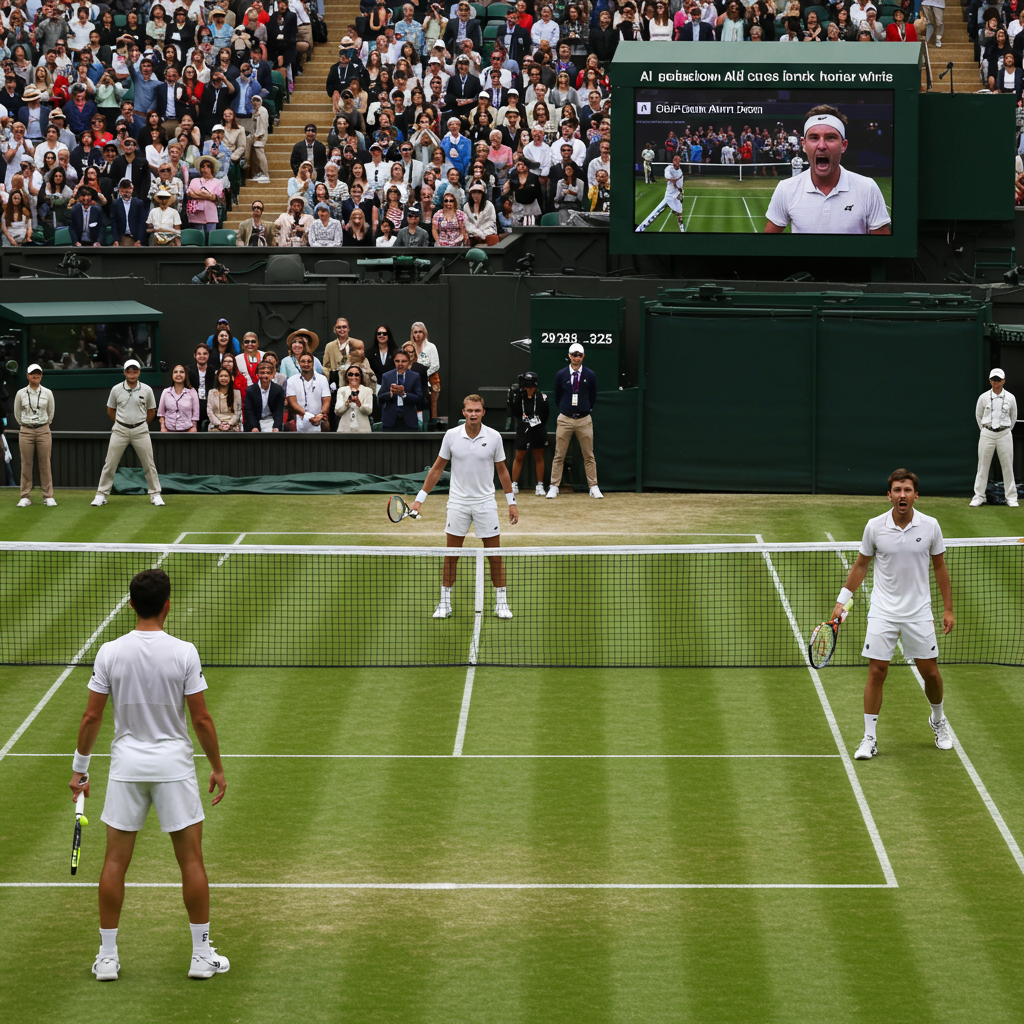wimbledon 2025 brought a monumental shift to its iconic courts: the full-scale replacement of human line judges with electronic line-calling (ELC) technology, significantly enhanced by artificial intelligence. Organizers may have anticipated some pushback—perhaps lamenting the loss of tradition or raising concerns over the jobs of roughly 300 linespeople. However, few could have predicted the intense “firestorm” of controversy that erupted just days into the tournament. This technological leap, intended to usher Wimbledon into a new era of precision, instead ignited a debate about accuracy, reliability, and the human element in professional tennis, leaving many players questioning their trust in the automated system.
The AI Takeover on Court
Electronic line-calling, powered by sophisticated ball-tracking technology like Hawk-Eye, is not a complete newcomer to the tennis world. Its roots in pro circuits trace back to the Next Gen ATP Finals in 2018. The Australian Open embraced it as the first Grand Slam in 2020. By 2025, the ATP Tour adopted ELC across all its events, barring clay tournaments. This widespread implementation meant that by the time Wimbledon made its move, only the French Open among the Grand Slams still relied exclusively on human officials for line calls. Wimbledon’s adoption, therefore, seemed a natural progression, positioning the All England Club alongside other major events in embracing advanced technology for decision-making on court.
However, rather than a seamless transition into the future, Wimbledon’s first week of ELC implementation was spent largely on the defensive. The system, utilizing ten cameras strategically positioned around each court to track the ball’s bounce with a claimed margin of error of just 2.2mm, faced immediate scrutiny. This was particularly notable given Wimbledon had previously only used Hawk-Eye as a player challenge system, a safety net layered over human calls.
Early Doubts Emerge
The initial waves of criticism came from high-profile sources: the British No 1 players, Jack Draper and Emma Raducanu. Both spoke out following their respective defeats, expressing frustration and skepticism regarding the ELC system’s accuracy. Raducanu specifically highlighted several calls in her matches that she felt were “very wrong.” Her comments, echoed by Draper, signaled that player concerns weren’t isolated incidents but were becoming a noticeable theme early in the tournament. These public statements from prominent home favorites only amplified the growing disquiet around the new technology.
The All England Lawn Tennis Club (AELTC) stood by its decision. They maintained that the ELC system was functioning optimally and argued it was inherently more accurate than human judgment. Debbie Jevans, the chair of the AELTC, even pointed out the irony: “It’s funny, because when we did have linesmen, we were constantly asked why we didn’t have electronic line-calling because it’s more accurate.” This perspective underscored the organizers’ belief that they were adopting a demonstrably superior system, despite the unfolding issues.
The Centre Court Debacle
The controversy reached a boiling point during a match on Centre Court between Anastasia Pavlyuchenkova and Sonay Kartal. At a critical juncture—Pavlyuchenkova holding game point on her serve in the first set—a backhand from Kartal appeared long to many observers. The ELC system, however, remained silent; no “out” call was made. What followed was a lengthy and confusing delay. Umpire Nico Helwerth, initially unaware of the technical issue, announced the system was “unable to track the last point.”
The stunning revelation emerged that some ELC cameras on Pavlyuchenkova’s side of the court had been accidentally deactivated by an operator. This human error meant the technology was simply not functional in that section of the court during the preceding points. Three calls were missed by the live system during this period. After consulting a review official, the umpire made the decision to replay the point, a ruling that deeply frustrated Pavlyuchenkova.
“They Have Stolen the Game From Me”
Pavlyuchenkova’s reaction was swift and impassioned. She confronted the umpire, stating, “You cannot prove it, because she’s local they can say whatever. You took the game away from me… They have stolen the game from me, they stole it.” Her accusation, particularly referencing potential home bias (Kartal is British), highlighted the intense pressure and distrust the technical failure had created. Though Pavlyuchenkova eventually won both the set and the match, mitigating the immediate impact of the error on the final result, the incident served as a stark, public demonstration that the new system was far from infallible.
The AELTC quickly issued a statement acknowledging the accidental deactivation by an operator and apologizing to both players. Wimbledon chief executive Sally Bolton addressed the media the following morning, attributing the issue squarely to human error and insisting that protocols had been reviewed and changed to prevent recurrence. She asserted that the ELC system was otherwise performing accurately throughout the tournament. Nevertheless, the incident underscored the undeniable need for robust contingency plans when relying so heavily on technology, potentially including clear guidelines for umpires on using video replay or making subjective calls when the system fails.
Player Faith Wanes on Grass
Historically, player reaction to ELC on hard courts has been largely positive, with many acknowledging its objective accuracy compared to the occasional mistakes made by human judges. However, the transition to other surfaces has proved more challenging. The clay-court season saw players express frustration over discrepancies between the automated calls and the visible ball marks left on the surface.
The challenging first week at Wimbledon 2025 indicates that faith in the system’s implementation on grass courts has also significantly diminished. While the AELTC promotes its accuracy, players and coaches have privately and publicly voiced skepticism about how reliably the technology tracks the ball’s interaction with the unique grass surface. The combination of early player complaints, a major public system failure attributed to human error, and ongoing private doubts has created a climate of mistrust. As the championships advance into their later stages, the question remains whether player confidence in the Wimbledon AI line calling system can be rebuilt.
Frequently Asked Questions
What is the controversy surrounding AI line calling at Wimbledon 2025?
Wimbledon fully replaced human line judges with electronic line-calling (ELC), enhanced by AI, for the first time in 2025. This move sparked controversy due to perceived incorrect calls by players like Emma Raducanu and Jack Draper, culminating in a significant system failure on Centre Court. The reliance on technology over human judgment and concerns about accuracy, particularly on grass, have shaken player confidence.
How did the major system failure involving Anastasia Pavlyuchenkova happen?
During Anastasia Pavlyuchenkova’s match, the ELC system failed to call a seemingly long ball on a crucial point. It was revealed that some cameras on her side of the court had been accidentally deactivated by an operator, rendering the system non-functional in that area for a period. This human error led to missed calls, confusion, a lengthy delay, and the umpire deciding to replay the point, much to Pavlyuchenkova’s vocal frustration.
Why are players expressing skepticism about the electronic line calling on grass?
While ELC has been well-received on hard courts, its application on clay and grass surfaces has faced more player skepticism. Although the technology tracks the ball bounce, players have expressed doubts about its absolute accuracy on grass, perhaps due to the unique way the ball interacts with the surface. Specific incidents and technical failures at Wimbledon 2025 have further eroded confidence, leading players and coaches to voice concerns about the system’s reliability on the iconic grass courts.
The initial rollout of AI-enhanced electronic line-calling at Wimbledon 2025 has proven to be anything but smooth. What was intended as a step forward in precision and modernization has instead highlighted the complexities and potential pitfalls of relying solely on automated systems in high-stakes sporting environments. From early player doubts to a critical system failure, the drama surrounding the technology has significantly impacted the narrative of the tournament’s first week. As Wimbledon progresses, the focus will remain not just on the matches themselves, but on whether the controversial technology can regain the trust of the athletes whose careers depend on its accuracy.



